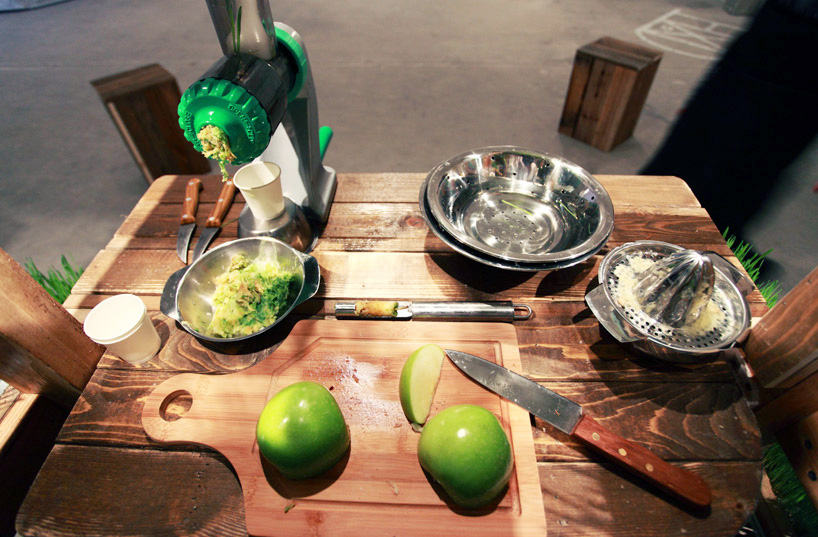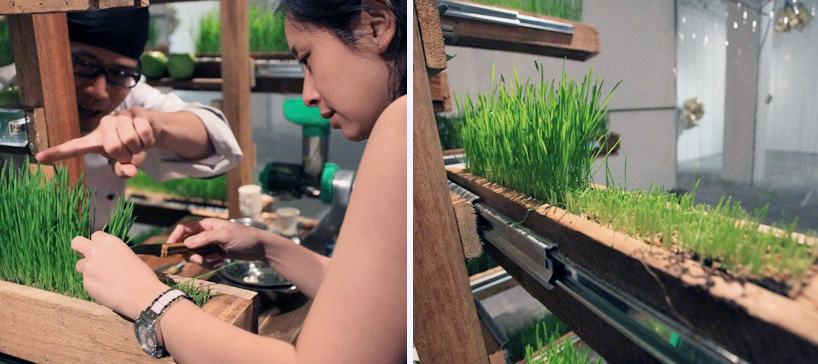این کار رو دوست داشتم! ولی می خوام در حاشیه اش حرفی دیگه بزنم. چون به نظرم خلاقیت و ابتکارش بیشتر مورد توجه م قرارگرفت.
درسته این یک کار نمایشگاهیه. اما شما بیاین فرض کنین کسی امروز در خیابونهای همین شهرهای ما چنین دکه ای بنا کنه و به مردم آب سیب و جوانه گندم بده! چه میزان فروش میکنه؟ به نظر حتی اگر هرچقدر هم گرون بفروشه باز هم جذابیتهای موجود در کارش منجر می شه که مشتریش رو پیدا کنه...
سوال اینجاست که چرا مشاغل مختلف ما به سمت ایده پردازی و نوآوری در کارهاشون نمی رن؟
من فکر می کنم ما با تعریف نظام آموزشی خودمون و سوق دادن هرکس که اندک زمینه های خلاقانهای داشته به سمت علوم و دانستههای غیرخلاقه، راه رو برای تنفس و نوبهنو شدن جامعه مون تنگ کردیم . فکر می کنم با این روند اگرچه موشکهای ساخته ما هر روز قوی ترو دوربردتر خواهد شد -و البته شکر خدا را برای این قدرت و صلابت- اما خلاقیت و ابتکار و هنر در این ملک هر روز بیشتر رو به افول خواهد رفت....
خانواده ها ! کاش براتون روشن بشه که برای بچه هاتون، مهندس و دکتر شدن به همون اندازه خوب و لازمه که هنرمند و تاثیرگذاری فرهنگی در جامعه شدن...

'transform bar' by kacey wong, 2012
all images courtesy the artist
hong kong-based artist kacey wong has sent to designboom his newest experimental sculpture, 'transform bar'. the 3 x 4 foot juice stand has been built from re-purposed wood, the natural planks joined in such a way to create planters with wheat grass growing from the rectangular boxes. these greenery growing containers are connected to the vertically elongated shop by a wheel-in-track drawer system and in this way, are able to extended from the main structure with ease to maximize sunlight from all angles to aid the growth of the grass. wong developed the bar for he, himself to stand inside of-- mixing apple and wheat grass juices within the confines of the structure in order to raise awareness of the food source system and what the artist sees as 'extending art appreciation to the sense of taste and consumption'.
'transform bar' was created with the image of hong kong street hawkers’ stalls in mind. wong says of his artwork in comparison to the original food stalls of the bustling city streets that, 'in order to survive, the owner of the hawkers’ stalls will push out and pull back their merchandise in different times of the day, forming a flexible system. 3 feet by 4 feet is only so big, the merchandise have to match the market demand in order to sustain a proper living, running the business also have to be flexible and legal. it could also be said that the hong kong way to survive is to be adoptive with the environment through transformation'.
the juice bar work is on exhibition at osage [kwun tong] gallery until the 9th of june, 2012.

the juice bar when the track and wheel arms have been brought in

a visualization of the grass growing on the piece

while the exterior shelves house a long rectangular stretch of grass, while the interior system boasts a collection of apples

the juicing work station in use

the artist with his work in the gallery space

users of the piece harvest a small segment of grass with a small blade to add to the juice mix

gallery view of 'transform bar'

various perspectives of the piece picturing the finished 'transform bar' (left) and work in progress (right views)

'transform bar' took its form from a pile of scrap wood gathered by the artist

each plank of wood which build the work are recycled material





















